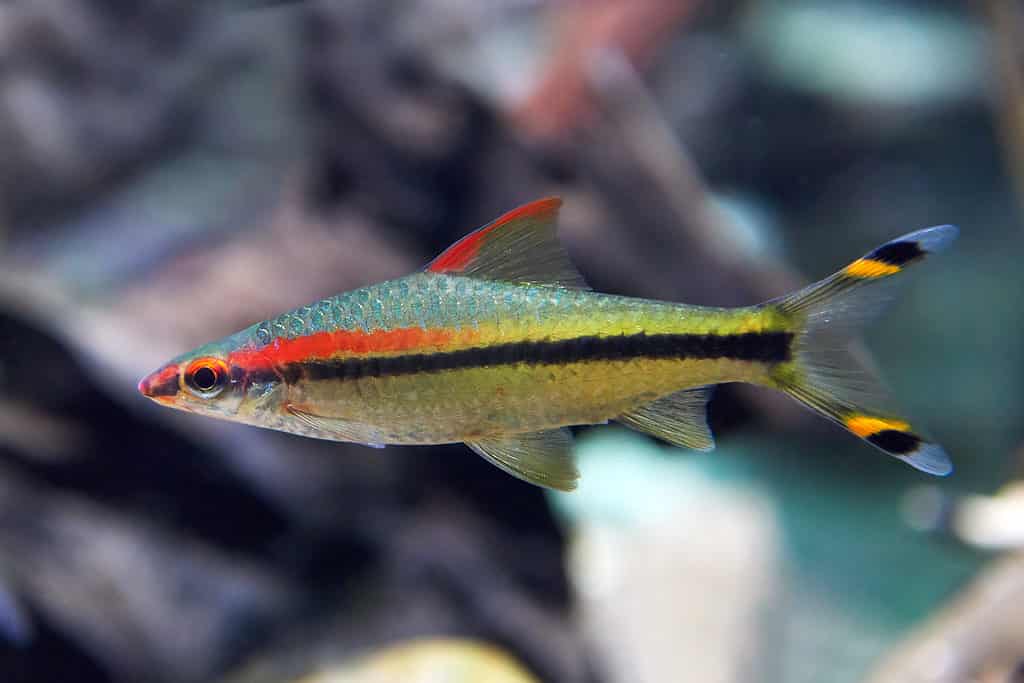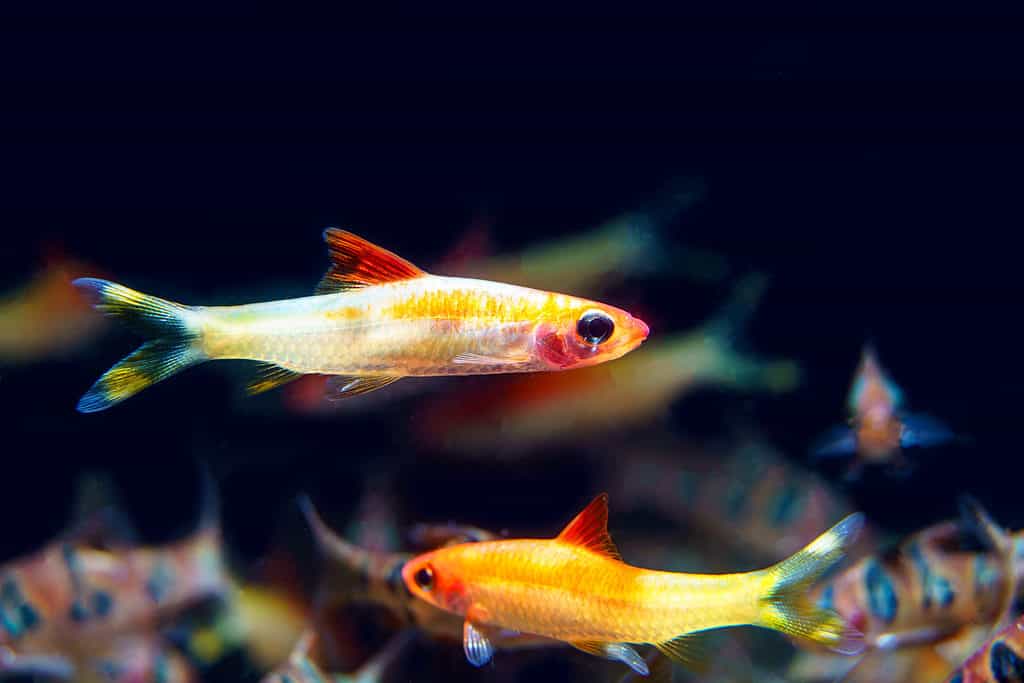The Denison barb is native to Kerala and Karnataka areas, located in the southern part of India. These schooling fish are native to streams and rivers surrounding dense vegetation and rocky terrain.
This slender yet flexible fish have a peaceful nature but are also very active and fast-moving. Their beautiful markings and bright multitoned colors shimmer in the reflection of the water’s surface as they show off their beauty.
What Made the Denison Barb So Popular

A Denison barb.
©Dennis Jacobsen/Shutterstock.com
The Denison barb species became increasingly high in demand as the aquatic market flourished due to their striking appearance. The fish is widely known as an ornamental fish.
There is a significant amount of depletion as their habitat is often mistreated due to deforestation, overfishing, and human pollution. Unfortunately, these fish are now on the IUCN red list, which has placed them as an endangered species.
Physical Characteristics of the Denison Barb
Their bodies are long and display the shape of a torpedo. The Denison barb is extremely agile underwater due to its lightweight and fast-moving body.
The Denison barb colors and markings are what makes this fish so unique. The base color of their body is silver, where a solid black line runs sideward along the middle length of the body as it connects from the snout and ends at the tail.

Depending on their skin and lighting conditions, a glisten of gold tones may appear on the Denison barb’s scales.
©chonlasub woravichan/Shutterstock.com
In addition, the dorsal fin has a touch of red and yellow, and the caudal fin has touches of black and yellow. Finally, in some cases, a glisten of gold tones may appear on their scales, depending on their skin, and lighting conditions.
Denison Barb Habitat and Care
Before homing these beautiful fish, several factors must be considered to ease their transition to a new environment. As the Denison barb can reach a size of six inches, a large aquarium is a requirement. Because they are highly active, they need a spacious area to move freely and not feel confined.
The ideal water conditions for the Denison barb must have a PH value of around 6.5 and 7.5. An ideal water temperature is 59 to 79 degrees Fahrenheit. A high-quality water pump and filtration system will do the trick as this will mimic a rapidly flowing water stream to represent their natural habitat.
These fish can become hypersensitive when their water conditions are not optimal. If the water becomes contaminated, these fish are inclined to develop the itch. This parasitic disease needs to be attended to immediately as it could deteriorate your Denison’s lifespan.
If your fish is experiencing the ich, you will notice the following:
- White spots develop on their fins and skin
- Abnormal wandering behavior
- Lethargic
- Hiding at the bottom of the tank, not socializing
If you want your Denison barb to heal from ich, transfer him to another tank with water with a balanced PH level and freshwater plants. This uncontaminated environment will give the fish time to heal and prevent passing on ich to all his other fish mates.
Remember not to keep this fish in a plain water tank with no vegetation, as this can cause them to lose color pigments on the skin.
Vegetation also plays an essential role in keeping these fish alive and healthy. In addition, creating a natural habitat in your aquarium will allow these fish to thrive on plant species and explore an adventurous rocky terrain. Types of vegetation such as Java Fern, Amazon Fern, and Anubias will create a natural ecosystem bringing these fish back to their roots. These plants will provide the following:
- Oxygen during the day
- increase water quality
- prevention of algae growth
- shelter for your fish
- different areas to explore
Denison Barb Diet
These omnivores will eat a variety of food which includes plants and animals. The Denison fish love to eat food and will chow down on any food group that gets delivered to their tank. Although, if fed the same food group for an extended period, they can become uninterested, so switching up their menu as an assortment of food will keep their tastebuds alive.
Foods they enjoy include:
- Earthworms
- Chopped zucchini and squash
- Blood worms
- Brine shrimp
- Daphnia
- Cyclops
These foods can be fed to them live, frozen, or freeze-dried.
Tankmates for the Denison Barb
The Denison barb expresses a calm nature, but if placed in a smaller tank, this fish can show signs of aggression. With them darting around, this can cause injuries and uproar in the tank. Choose a group of fish that are similar in size, and that will be compatible with your Denison Barb.
These well-suited fish include:
- Rainbow fish
- Tiger Barb
- Cherry Barb
- Rosy Barb
- Celestial Pearl Danio
- Apistogramma
In the appropriate environment, Denison barbs will be healthy and happy for as long as five years. The Denison barb is a phenomenal fish, so if you become an owner, you will be mesmerized by its uniqueness and beauty.
Up Next
The photo featured at the top of this post is © chonlasub woravichan/Shutterstock.com
Sources
- seriously fish, Available here: https://www.seriouslyfish.com/species/sahyadria-denisonii/
- aquariadise, Available here: https://www.aquariadise.com/denison-barbs/
- fish keeping world, Available here: https://www.fishkeepingworld.com/denison-barb/
FAQs (Frequently Asked Questions)
How many denison barbs should be kept together?
There should not be more than six denison barbs kept in the tank as these fish are schooling fish.
What do denison barbs eat?
Foods they enjoy include Earthworms, blood worms, brine shrimp,daphnia, cyclops, and chopped zucchini.
What temperature do barbs prefer?
The ideal temperature range should be between fifty-nine to seventy-seven degrees Fahrenheit.
Thank you for reading! Have some feedback for us? Contact the AZ Animals editorial team.






